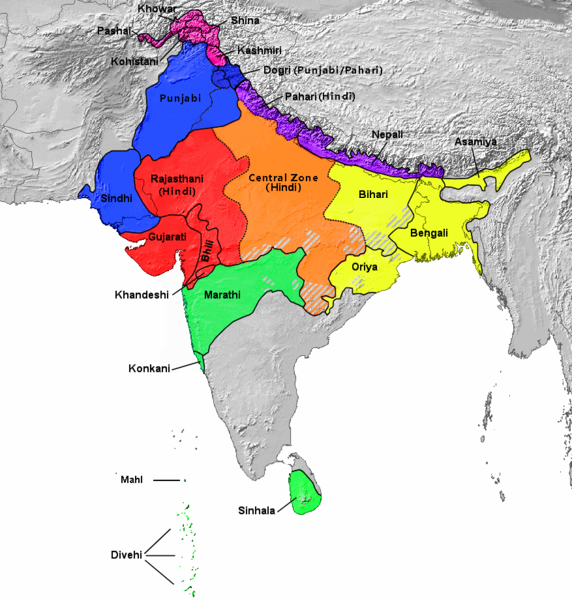INDO
- ARYAN PEOPLES

1978
map showing geographical distribution of the major Indo-Aryan languages.
(Urdu is included under Hindi. Romani, Domari, and Lomavren are
outside the scope of the map.) Dotted/striped areas indicate where
multilingualism is common.
The
Indo-Aryan peoples (or Indic peoples) are a diverse collection of
ethnolinguistic groups speaking Indo-Aryan languages, a subgroup
of the Indo-European language family. Indo-Aryan peoples are native
to the northern Indian subcontinent, and presently found all across
South Asia, where they form the majority.
Languages
: Indo-Aryan languages
Religion : Indian religions (Mostly Hindu; with Buddhist,
Sikh and Jain minorities) and Islam, Christians and some non-religious
atheist/agnostic
History
:
The Indo-Aryan migration theory, proposed among others by anthropologist
David W. Anthony (in The Horse, The Wheel and Language) and by archaeologists
Elena Efimovna Kuzmina and J. P. Mallory, shows that the introduction
of the Indo-Aryan languages in the Indian subcontinent was the result
of a migration of people from the Sintashta culture through the
Bactria-Margiana Culture and into the northern Indian subcontinent
(modern-day India, Nepal, Bangladesh, Pakistan and Sri Lanka). These
migrations started approximately 1,800 BCE, after the invention
of the war chariot, and also brought Indo-Aryan languages into the
Levant and possibly Inner Asia and western China. The Proto-Indo-Iranians,
from which the Indo-Aryans developed, are identified with the Sintashta
culture (2100–1800 BCE), and the Andronovo culture, which
flourished ca. 1800–1400 BCE in the steppes around the Aral
sea, present-day Kazakhstan, Uzbekistan and Turkmenistan. The proto-Indo-Iranians
were influenced by the Bactria-Margiana Culture, south of the Andronovo
culture, from which they borrowed their distinctive religious beliefs
and practices. The Indo-Aryans split off around 1800–1600
BCE from the Iranians, whereafter the Indo-Aryans migrated into
the Levant and north-western India and western China. This migration
was part of the diffusion of Indo-European languages from the Proto-Indo-European
homeland at the Pontic steppe which started in the 4th millennia
BCE.
The
Indo-Aryans were united by shared cultural norms and language, referred
to as arya, "noble." Diffusion of this culture and language
took place by patron-client systems, which allowed for the absorption
and acculturalisation of other groups into this culture, and explains
the strong influence on other cultures with which it interacted.
The
alternate Indigenous Aryans theory places the Indo-Aryans languages
as being entirely indigenous to the Indian subcontinent and later
they spread outside the subcontinent; this theory has no support
in mainstream scholarship.
List
of Indo-Aryan peoples :
Historical |
Contemporary |
•
Angs
• Bahliks
• Bharats
• Chedi
• Gandharis
• Gangaridai
• Gupta
• Kambojs
• Kaling
• Kasmir
• Kekaye
• Khasas
• Kikat
• Kosal
• Kurus
• Licchavis
• Madra
• Magadhis
• Malavas
• Mallas
• Matsya
• Maurya
• Nand
• Nishadhas
• Odra
• Pakthas
• Pal
• Panchal
• Pulinds
• Paundra
• Puru
• Raghuvanshi
• Rashtrakut
• Rigvedic tribes
• Salv
• Salwa
• Saraswat
• Sauvir
• Sen
• Shakya
•
Sindhu
• Sudra
• Sursen
• Trigart
• Utkal
• Vang
• Vats
• Vidarbh
• Videh
• Yadav
• Yadu
• Yaksh |
•
Assamese people
• Awadhi people
• Banjara people
• Bengali people
• Bhil people
• Bhojpuri people
• Bishnupriya Manipuri people
• Chakma people
• Dardic People
• Deccani people
• Dhivehi people
• Dogra people
• Garhwali people
• Gujarati people
• Halba people
• Haryanvi people
• Jaunsari people
• Kalash people
• Kamrupi people
• Kashmiri people
• Khas people
• Konkani people
• Kumauni people
• Kutchi people
• Magahi people
• Maithil people
• Marathi people
• Marwari people
• Nagpuri people
• Odia people
• Punjabi people
• Rajasthani people
• Romani people
• Rohingya people
• Saraiki people
• Saurashtra people
• Sindhi people
• Sinhalese people
• Tharu people
• Warli
|
Archaeological
cultures associated with Indo-Iranian migrations (after EIEC). The
Andronovo, BMAC and Yaz cultures have often been associated with
Indo-Iranian migrations. The GGC, Cemetery H, Copper Hoard and PGW
cultures are candidates for cultures associated with Indo-Aryan
migrations.
Source
:
https://en.wikipedia.org/
wiki/Indo-Aryan_peoples

